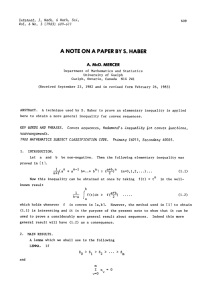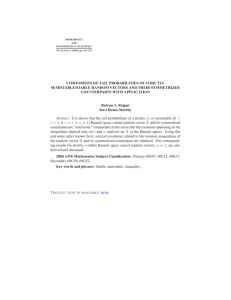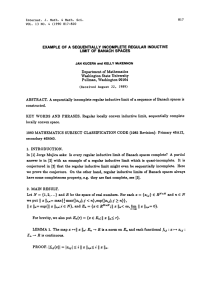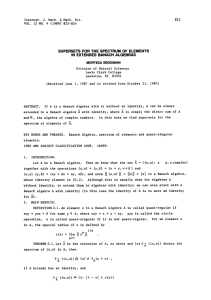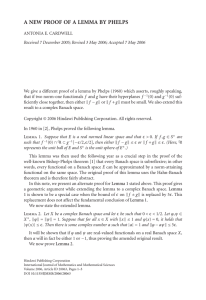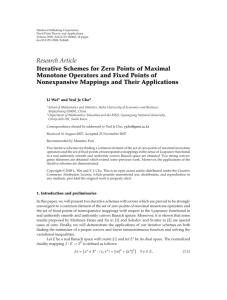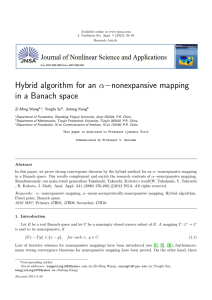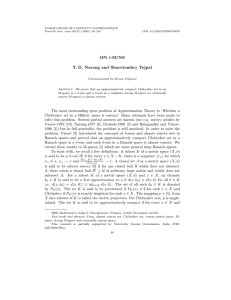Document 10468919
advertisement
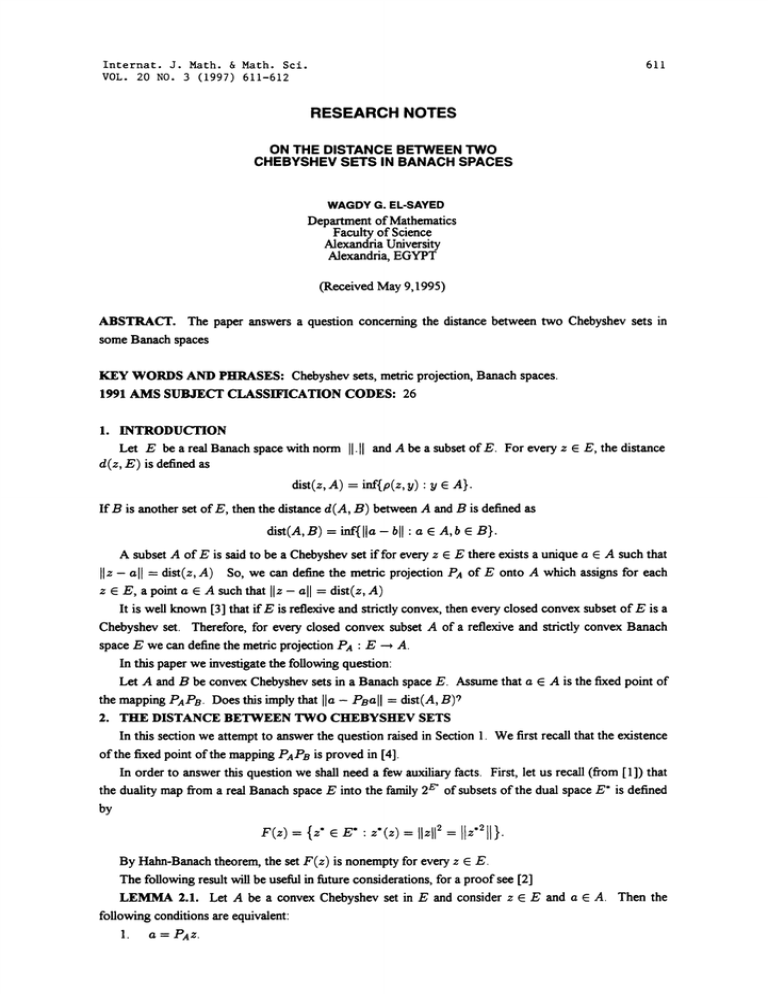
Internat. J. Math. & Math. Sci.
VOL. 20 NO. 3 (1997) 611-612
611
RESEARCH NOTES
ON THE DISTANCE BETWEEN TWO
CHEBYSHEV SETS IN BANACH SPACES
WAGDY G. EL-SAYED
Department of Mathematics
Faculty of Science
Alexandria University
Alexandria, EGYPT
(Received May 9,1995)
ABSTRACT. The paper answers a question concerning the distance between two Chebyshev sets in
some Banach spaces
KEY WORDS AND PHRASES: Chebyshev sets, metric projection, Banach spaces.
1991 AMS SUBJECT CLASSICATION CODES: 26
1. INTRODUCTION
Let E be a real Banach space with norm
d (z, E) is defined as
[[. and A be a subset of E. For every z E E, the distance
dist(z, A)
inf{p(z,y): y E A}.
If B is another set of E, then the distance d(A, B) between A and B is defined as
dist(A, B)
inf{ll bll:
A,b
B}.
A subset A of E is said to be a Chebyshev set if for every z E E there exists a unique a E A such that
dist(z, A) So, we can define the metric projection PA of E onto A which assigns for each
z E, a point a A such that IIz 11 dist(z, A)
It is well known [3] that if E is reflexive and strictly convex, then every closed convex subset of E is a
Chebyshev set. Therefore, for every closed convex subset A of a reflexive and strictly convex Banach
space E we can define the metric projection PA E --, A.
In this paper we investigate the following question:
Let A and B be convex Chebyshev sets in a Banach space E. Assume that a A is the fixed point of
the mapping PAPB. Does this imply that I1 Psall dist(A, B)?
2. THE DISTANCE BETWEEN TWO CHEBYSltEV SETS
In this section we attempt to answer the question raised in Section 1. We first recall that the existence
of the fixed point of the mapping P.4PB is proved in [4].
In order to answer this question we shall need a few auxiliary facts. First, let us recall (from ]) that
the duality map from a real Banach space E into the family 2 E" of subsets of the dual space E* is defined
by
IIz all
F(z)
{z"
E" z*(z)=
Ilzl12 liz.ll}.
By Hahn-Banach theorem, the set F(z) is nonempty for every z E E.
The following result will be useful in future considerations, for a proof see [2]
LEMMA 2.1. Let A be a convex Chebyshev set in E and consider z E and a
following conditions are equivalent:
1.
a=PAz.
A. Then the
612
W G EL-SAYED
2. For any x E A, there exists z* E F(z a) such that z* (x a) _< 0
By means of the duality map F we can define the so-called semi-inner products"
(z,x)_ -inf{z*(z): z"
(z,x)+ sup{x’(z): z
F(z)},
F(z)}.
The properties of these semi-inner products are given in [1 ]. For our further purposes we will need
the following lemma, see 1]
LEMMA 2.2. Let E be a real Banach space such that E* is strictly convex Then the duality map F
is single-valued and the relation
(z,x)+
(z,x)_
forall z,z
E
holds Moreover, we have
(z + z, ) <_ (, a) + (, ),
2. I(z,z)l_< Ilzllllzll,
3. (z / z, z) (, z) / Ilzll
,
4.
(-=,
z)= (=, ).
Now we give our main result that partly answers the above question.
THEOREM 2.1. Let//7 be a real Banach space with strictly convex dual E*. Assume that A and B
are two Chebyshev sets in E and a A is a fixed point of the map PAPB. Then
[a PBa{
PROOF. For convenience, let b
points x E A and / B such that
Now, since a
PAb and b
dist(A, B).
Psa. Now suppose the converse.
Psa and applying Lemma
This means that there exist
and Lemma 2 we obtain
(x-a,b-a) < O,
(il-b,a-b) s O.
Hence by Lemma 2 we obtain
O> (z-a,b-a)+(y-b,a-b)
>
>
>
>_
(x-a,b-a)+(b-l,b-a)
(z-a+b-y,b-a)
(x-y+b-a,b-a)
(
,
,) + I1 ,ll
.
Consequemly
lib all S
(z
/, b-
a) S llz
II lib
all,
which implies that
lib- all
I1 x/ll,
The last inequality comradicts inequality (2.1) and completes the proof.
REFERENCES
[1 DE MLING, K., Ordinary Differential Equations m Banach Spaces, Springer, Berlin-Heidelberg,
New York, 1977.
[2] GOEBEL, K. and REICH, S., Uniform Convexity, Hyperbohc Geometry, and Nonetve
Mappings, Marcel Dekker, New York, 1984.
[3] KOTHE, G., Topological Vector Spaces l, Springer, Berlin, 1969.
[4] EL-SAYED, W.G., A note on a fixed point property for metric projections, Tamk. J. Math., Tamk.
Univ., Taiwan, China, Vol. 27, No. 2, 1995.


